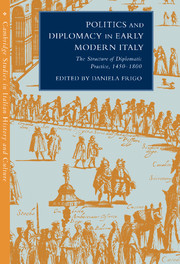Book contents
- Frontmatter
- Contents
- Introduction
- Diplomacy and government in the Italian city-states of the fifteenth century (Florence and Venice)
- Aspects of Medicean diplomacy in the sixteenth century
- An outline of Vatican diplomacy in the early modern age
- Economic and social aspects of the crisis of Venetian diplomacy in the seventeenth and eighteenth centuries
- ‘Small states’ and diplomacy: Mantua and Modena
- Neapolitan diplomacy in the eighteenth century: policy and the diplomatic apparatus
- Savoyard diplomacy in the eighteenth century (1684-1798)
- Index of names
- CAMBRIDGE STUDIES IN ITALIAN HISTORY AND CULTURE
Neapolitan diplomacy in the eighteenth century: policy and the diplomatic apparatus
Published online by Cambridge University Press: 29 October 2009
- Frontmatter
- Contents
- Introduction
- Diplomacy and government in the Italian city-states of the fifteenth century (Florence and Venice)
- Aspects of Medicean diplomacy in the sixteenth century
- An outline of Vatican diplomacy in the early modern age
- Economic and social aspects of the crisis of Venetian diplomacy in the seventeenth and eighteenth centuries
- ‘Small states’ and diplomacy: Mantua and Modena
- Neapolitan diplomacy in the eighteenth century: policy and the diplomatic apparatus
- Savoyard diplomacy in the eighteenth century (1684-1798)
- Index of names
- CAMBRIDGE STUDIES IN ITALIAN HISTORY AND CULTURE
Summary
THE KINGDOM OF NAPLES AND FOREIGN POLICY CHOICES
As in the case of the other Italian states of the eighteenth century, there is a large body of literature on the kingdom of Naples and its international relations, but nothing has been written on its diplomatic apparatus or on topics relating to it.
I shall not insist here upon the importance of the institutional aspect of diplomacy, since this has been amply dealt with elsewhere. I shall merely make clear that, given these gaps, this essay will seek to delineate the apparatus created by the Bourbons of Naples in the early period of their reign. It will highlight a number of key features and will concentrate in particular on the interweaving of foreign policy and the domestic situation so inuential on diplomacy in its structures and nature,since this was tied to society and especially to the milieu of the nobility and the court. I shall seek, in fact, to convey the particular significance of the connection evident throughout the eighteenth century between the evolution of Neapolitan diplomacy and (a) the growth of the society which became a nation and which, in Galasso's words, created its own ‘way to development’ by following its maritime and commercial vocation as propounded by neo-mercantilist thought and later by the illuministi or Enlightenment thinkers, and (b) the disputed position allocated to the Kingdom in the international order as a power of secondary rank, with its own role and its own image, amid the constraints imposed by the old equilibrium and its upsetting by the emergence of new powers.
- Type
- Chapter
- Information
- Politics and Diplomacy in Early Modern ItalyThe Structure of Diplomatic Practice, 1450–1800, pp. 176 - 209Publisher: Cambridge University PressPrint publication year: 2000



